Innovative Nuclear Energy Systems: State-of-the Art Survey on Evaluation and Aggregation Judgment Measures Applied to Performance Comparison
Abstract
:1. Introduction
2. Studies and Projects on Multi-Criteria Assessment of NESs and NFCs
2.1. The IAEA/INPRO Related Studies and Projects
2.1.1. IAEA Nuclear Technology Basic Principles
2.1.2. INPRO Methodology

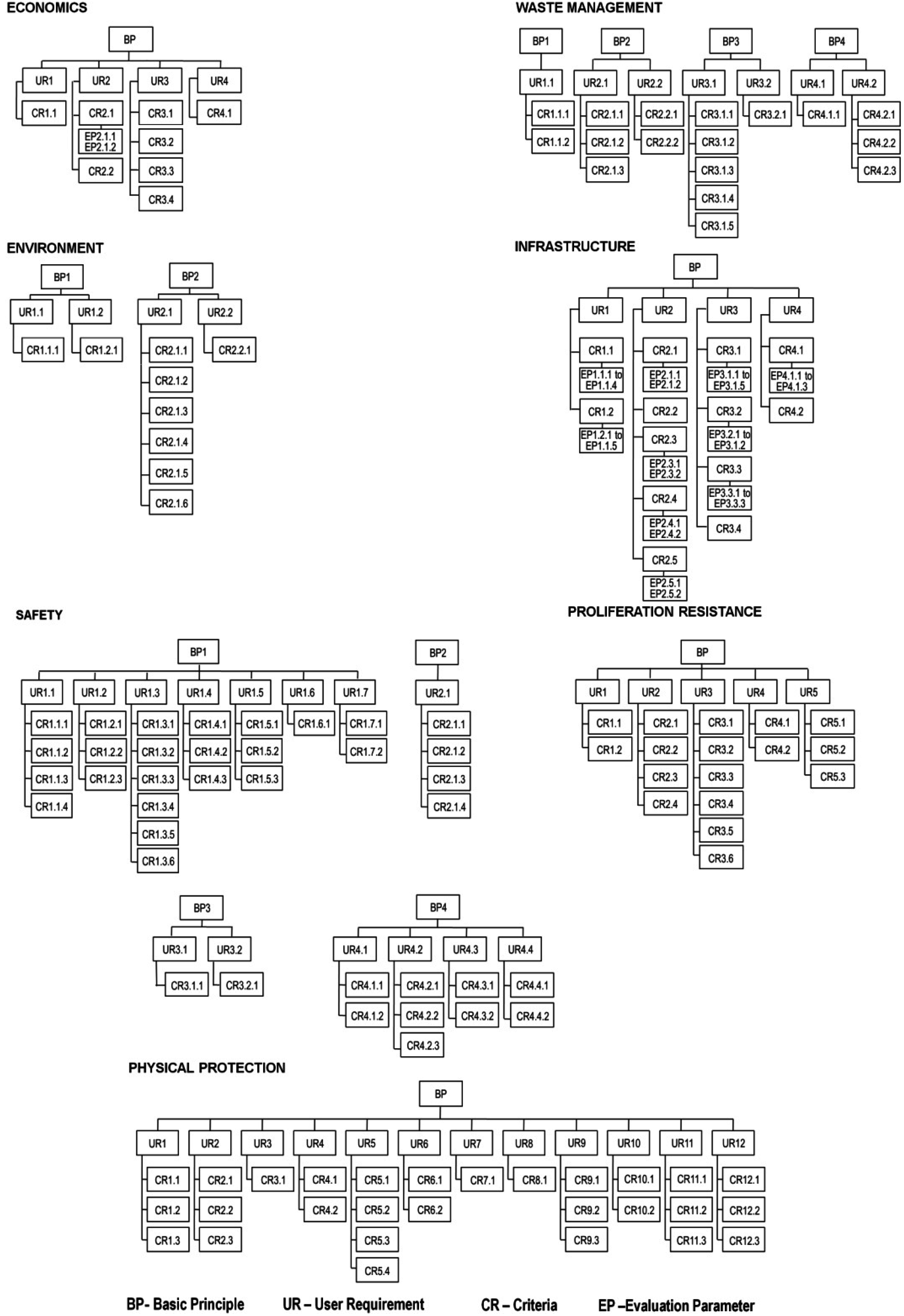
2.1.3. The GAINS Analytical Framework
- ▪
- Scenarios for long term nuclear power evolution based on IAEA Member States’ high and low estimates for nuclear power demand until 2050, and trend forecasts to 2100 based on projections of international energy organizations;
- ▪
- A so-called ‘heterogeneous’ global model to capture countries’ different policies regarding the back end of the NFC;
- ▪
- Metrics and tools to assess the sustainability of dynamic scenarios for a NES deployment, including a set of KIs and EPs;
- ▪
- An international database including characteristics of existing and future innovative nuclear reactors and associated NFCs for material flow analysis, which expands upon other IAEA databases and takes into account different preferences of Member States;
- ▪
- Findings from analyses of scenarios of a transition from present nuclear reactors and NFCs to future NES architectures with innovative technological solutions.
2.1.4. Nuclear Reactor Technology Assessment for Near Term Deployment
| No | Key Indicators and Evaluation Parameters | INPRO Assessment Areas | ||||||
|---|---|---|---|---|---|---|---|---|
| Color coding indicative of relative uncertainty level in estimating specific quantitative values for future NES (can vary based on a particular scenario) | Low | Resource Sustainability | Waste Management and Environmental Stressors | Safety | Proliferation Resistance and Physical Protection | Economics | Infrastructure | |
| Medium-Low | ||||||||
| Medium-high | ||||||||
| High | ||||||||
| Power Production | ||||||||
| KI-1 | Nuclear power production capacity by reactor type | X | ||||||
| EP-1.1 | (a) Commissioning and (b) decommissioning rates | X | X | |||||
| Nuclear Material Resources | ||||||||
| KI-2 | Average net energy produced per unit mass of natural uranium | X | X | |||||
| EP-2.1 | Cumulative demand of natural nuclear material, i.e., (a) natural uranium and (b) thorium | X | X | |||||
| KI-3 | Direct use material inventories per unit energy generated | X | X | X | ||||
| Discharged Fuel | ||||||||
| KI-4 | Discharged fuel inventories per unit energy generated | X | X | |||||
| Radioactive Waste Minor Actinides | ||||||||
| KI-5 | Radioactive waste inventories per unit energy generated | X | X | |||||
| EP-5.1 | (a) radiotoxicity (b) decay heat of waste, including discharged fuel destined for disposal | X | X | |||||
| EP-5.2 | Minor actinide inventories per unit energy generated | X | X | |||||
| Fuel Cycle Services | ||||||||
| KI-6 | (a) Uranium enriched and (b) fuel reprocessing capacity, both normalized per unit of nuclear power production capacity | X | X | |||||
| KI-7 | Annual quantities of fuel and waste material transported between groups | X | X | X | ||||
| EP-7.1 | Category of nuclear material transported between groups | X | ||||||
| System Safety | ||||||||
| KI-8 | Annual collective risk per unit energy generation | X | ||||||
| Cost and Investment | ||||||||
| KI-9 | Levelized unit of electricity cost | X | ||||||
| EP-9.1 | Overnight cost for Nth-of-a-kind reactor unit: (a) total and (b) specific (per unit capacity) | X | ||||||
| KI-10 | Estimated R&D investment in Nth-of-a-kind deployment | X | X | |||||
| EP-10.1 | Additional functions or benefits | X | ||||||
2.2. The NEA Related Studies and Projects
| Key Elements | A Number of Key Features | A Number of Key Sub-Features |
|---|---|---|
| Site specific considerations | 7 | 7 |
| Grid integration | 5 | 5 |
| Nuclear plant safety | 18 | 47 |
| Technical characteristics and performance | 10 | 59 |
| Nuclear fuel and NFC performance | 13 | 13 |
| Radiation protection | 9 | 9 |
| Environmental impact | 4 | 4 |
| Safeguards | 1 | 1 |
| Plant and site security | 6 | 6 |
| Owner’s scope of supply | 7 | 7 |
| Supplier/technology holder issues | 18 | 18 |
| Project schedule capability | 6 | 6 |
| Technology transfer and technical support | 7 | 9 |
| Economics | 5 | 26 |
2.2.1. Trends in the Nuclear Fuel Cycle
2.2.2. Advanced Nuclear Fuel Cycles and Radioactive Waste Management
| Criterion | Indicator | Measure | ||
|---|---|---|---|---|
| Economy | Economic competitiveness | Levelised NFC cost | USD/kWh (100%) | |
| Raw materials(U3O8 or Th) | USD/t (%) | |||
| Separation work | USD/SWU (%) | |||
| Conversion | USD/kgHM (%) | |||
| Fabrication | USD/kgHM (%) | |||
| Storage | USD/kgHM (%) | |||
| Reprocessing | USD/kgHM (%) | |||
| Transports | USD/kgHM (%) | |||
| Encapsulation and conditioning | USD/kgHM (%) | |||
| Disposal | USD/kgHM (%) | |||
| Financial expenditure | Total cost | USD | ||
| Technology availability | Research (govt.) | USD | ||
| Development (non-govt.) | USD | |||
| I: basic R&D | Years | |||
| II: laboratory/process | ||||
| III: pre-industrial | ||||
| IV: industrial | ||||
| Environment and Public Health | Use of non-renewable resources | Energy recovered per kg U | TWh/kg U | |
| Energy intensity | Ratio of necessary energy input to obtained output | % | ||
| Transportation | Range of ton-kilometers | t×km/kWh | ||
| Energy intensity ratio | % | |||
| Land occupation | Land area used | km2/kWh | ||
| Greenhouse gas emission | Amount of GHG emitted | t CO2 eq./kWh | ||
| Amount of waste | Total volume | m3/kWh | ||
| Volume at each life cycle step | m3/kWh | |||
| α-emitters | kg/kWh; Bq/kWh | |||
| γ-emitters | kg/kWh; Bq/kWh | |||
| Confinement time of waste | α-emitters | Years | ||
| γ-emitters | Years | |||
| Radiological impacts | Collective operational dose | manSv/kWh | ||
| Human health effects: acute fatalities | Operational accidents | # of immediate fatalities per accident | ||
| Society | Human resources, work opportunities | Change in work opportunity | person × year/kWh | |
| Work opportunity | person × year/kWh | |||
| Broad economic effects | Autonomy of resources | |||
| Induced industrial production | ||||
| Social aspects | Acceptance and risk aversion | |||
| Proliferation resistance | ||||
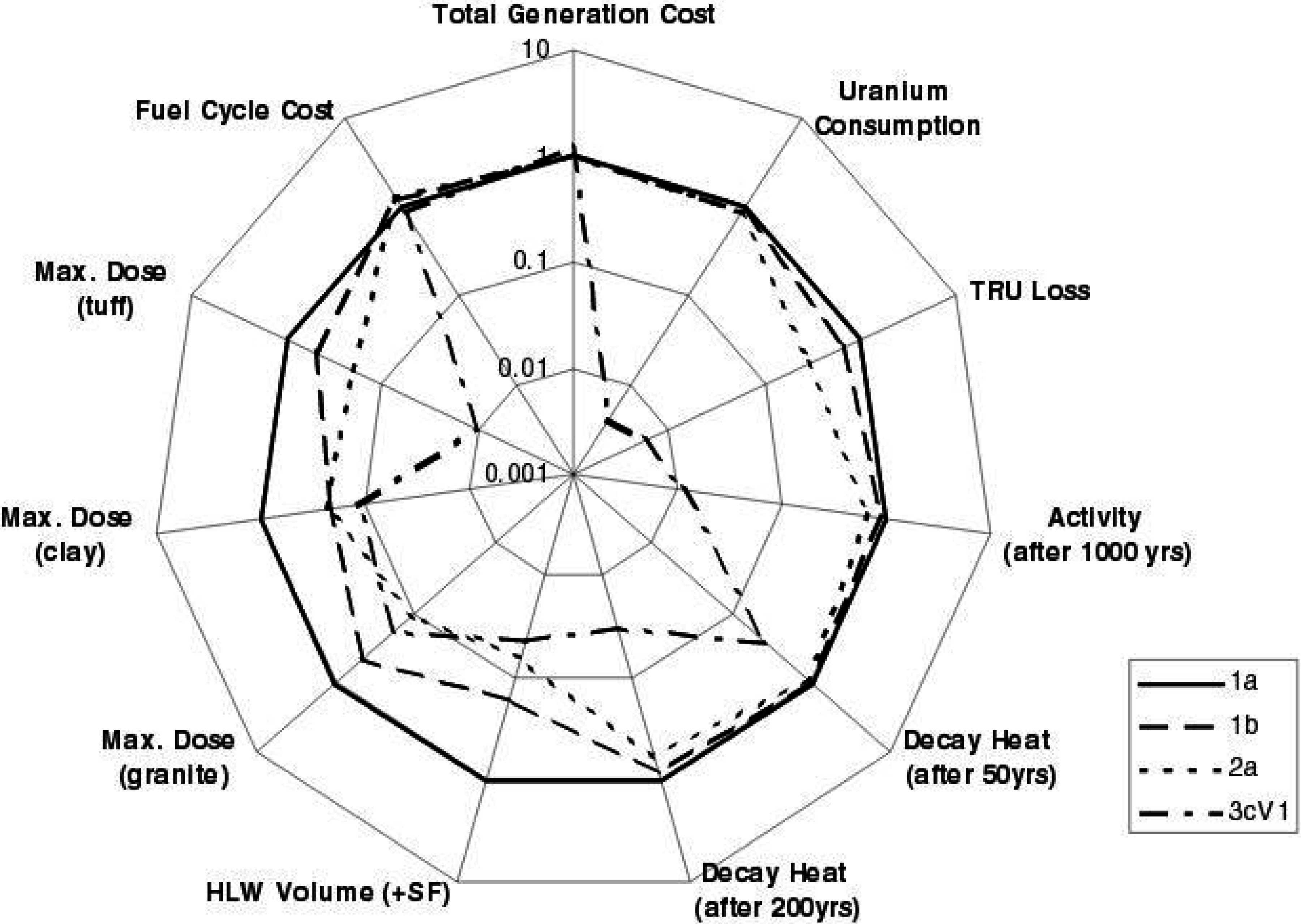
2.2.3. Potential Benefits and Impacts of Advanced Fuel Cycles with Partitioning and Transmutation
2.2.4. Generation IV International Forum (GIF) Methodology
- ▪
- Costs to research, develop, and demonstrate the reactor system;
- ▪
- Capital at risk;
- ▪
- Annual non-fuel operation costs;
- ▪
- Annual NFC costs;
- ▪
- Levelized unit of energy cost and its components.
- ▪
- Proliferation technical difficulty: The inherent difficulty, arising from the need for technical sophistication and materials handling capabilities, required to overcome the multiple barriers to proliferation;
- ▪
- Proliferation cost: The economic and staffing investment required to overcome the multiple technical barriers to proliferation, including the use of existing or new facilities;
- ▪
- Proliferation time: The minimum time required to overcome the multiple barriers to proliferation (i.e., the total time planned by the Host State for the project);
- ▪
- Fissilematerial type: A categorization of material based on the degree to which its characteristics affect its utility for use in nuclear explosives;
- ▪
- Detection probability: The cumulative probability of detecting a proliferation segment or pathway;
- ▪
- Detection resource efficiency: The efficiency in the use of staffing, equipment, and funding to apply international safeguards to the NES;
- ▪
- Probability of adversary success: The probability that an adversary will successfully complete the actions described by a pathway and it will generate a consequence;
- ▪
- Consequences—The effects resulting from the successful completion of the adversary’s action described by a pathway.
- ▪
- Qualitative safety features review;
- ▪
- Phenomena identification and ranking table;
- ▪
- Objective provision tree;
- ▪
- Deterministic and phenomenological analyses;
- ▪
- Probabilistic safety analysis.
2.3. The U.S. DOE Related Studies and Projects
2.3.1. The Future of Nuclear Power and Nuclear Fuel Cycle
2.3.2. Nuclear Fuel Cycle Evaluation and Screening
| EG | Short Description Indicative of NFCs in the Evaluation Group (EG) | NFC type |
|---|---|---|
| Once-through | ||
| EG01 | Once-through using enriched-U fuel in thermal critical reactors | |
| EG02 | Once-through using enriched-U fuel to high burnup in thermal or fast critical reactors | |
| EG03 | Once-through using natural-U fuel in thermal critical reactors | |
| EG04 | Once-through using natural-U fuel to very high burnup in fast critical reactors | *** |
| EG05 | Once-through using enriched-U/Th fuel in thermal or fast critical reactors | |
| EG06 | Once-through using Th fuel to very high burnup in thermal ADS | ** |
| EG07 | Once-through using natural-U fuel to very high burnup in thermal or fast ADS | ** |
| EG08 | Once-through using Th fuel to very high burnup in fast ADS | ** |
| Limited Recycle | ||
| EG09 | Limited recycle of U/TRU with new natural-U fuel to very high burnup in fast critical reactors | ** |
| EG10 | Limited recycle of 233U/Th with new Th fuel in fast and/or thermal critical reactors | *** |
| EG11 | Limited recycle of 233U/Th with new enriched-U/Th fuel in fast or thermal critical reactors | |
| EG12 | Limited recycle of U/Pu with new natural-U fuel in fast and/or thermal critical reactors | |
| EG13 | Limited recycle of U/Pu with new enriched-U fuel in thermal critical reactors | |
| EG14 | Limited recycle of U/Pu with new natural-U fuel in both fast and thermal critical reactors | *** |
| EG15 | Limited recycle of U/Pu with new enriched-U fuel in both fast and thermal critical reactors | |
| EG16 | Limited recycle of U/Pu with new enriched-U fuel in thermal critical reactors and fast ADS | |
| EG17 | Limited recycle of Pu/Th with new enriched-U/Th fuel in thermal critical reactors | |
| EG18 | Limited recycle of 233U/Th with new enriched-U/Th fuel in thermal critical reactors | |
| Continuous Recycle | ||
| EG19 | Continuous recycle of U/Pu with new natural-U fuel in thermal critical reactors | |
| EG20 | Continuous recycle of U/TRU with new natural-U fuel in thermal critical reactors | |
| EG21 | Continuous recycle of U/Pu with new enriched-U fuel in thermal critical reactors | |
| EG22 | Continuous recycle of U/TRU with new enriched-U fuel in thermal critical reactors | |
| EG23 | Continuous recycle of U/Pu with new natural-U fuel in fast critical reactors | * |
| EG24 | Continuous recycle of U/TRU with new natural-U fuel in fast critical reactors | * |
| EG25 | Continuous recycle of 233U/Th with new enriched-U/Th fuel in thermal critical reactors | |
| EG26 | Continuous recycle of 233U/Th with new Th fuel in thermal critical reactors | ** |
| EG27 | Continuous recycle of 233U/Th with new enriched-U/Th fuel in fast critical reactors | |
| EG28 | Continuous recycle of 233U/Th with new Th fuel in fast critical reactors | ** |
| EG29 | Continuous recycle of U/Pu with new natural-U fuel in both fast and thermal critical reactors | * |
| EG30 | Continuous recycle of U/TRU with new natural-U fuel in both fast and thermal critical reactors | * |
| EG31 | Continuous recycle of U/Pu with new enriched-U fuel in both fast and thermal critical reactors | |
| EG32 | Continuous recycle of U/TRU with new enriched-U fuel in both fast and thermal critical reactors | |
| EG33 | Continuous recycle of U/Pu with new natural-U fuel in both fast ADS and thermal critical reactors | ** |
| EG34 | Continuous recycle of U/TRU with new natural-U fuel in both fast ADS and thermal critical reactors | ** |
| EG35 | Continuous recycle of U/Pu with new enriched-U fuel in both thermal critical reactors and fast ADS | |
| EG36 | Continuous recycle of U/TRU with new enriched-U fuel in both thermal critical reactors and fast ADS | |
| EG37 | Continuous recycle of 233U/Th with new enriched-U/Th fuel in both fast and thermal critical reactors | ** |
| EG38 | Continuous recycle of 233U/Th with new Th fuel in both fast and thermal critical reactors | ** |
| EG39 | Continuous recycle of 233U/Th with new enriched-U fuel in both thermal critical reactors and fast ADS | |
| EG40 | Continuous recycle of 233U/Th with new Th fuel in fast ADS and thermal critical reactors | ** |
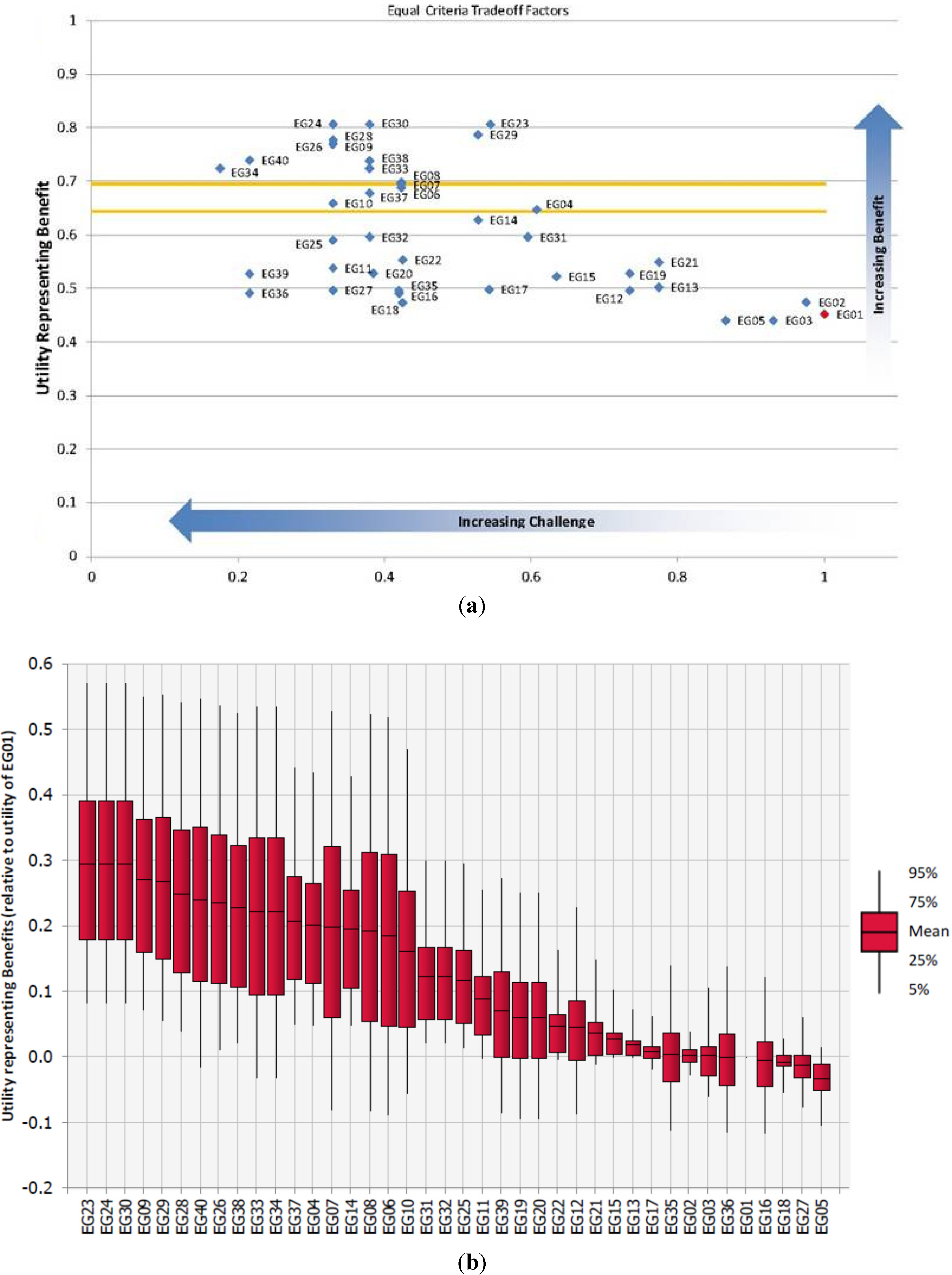
2.4. Initiative Studies
2.4.1. Research Articles and Initiative Studies
2.4.2. Performance Indicators
- ▪
- Economics area: net present value, discounted cost, internal rate of return, levelized cost, discounted payback period, overnight capital costs, etc.;
- ▪
- Non-proliferation area: different aggregation of material flows (plutonium risk exposure, total amount of fissile materials in the NFC, etc.), fissile materials production capabilities, attractiveness of nuclear materials and facilities, time needed to produce a certain quantity of fissile materials, along with others;
- ▪
- Waste management area: radiotoxicity, radioactivity, SNF and HLW amount and volume, peak dose rate, decay heat, time needed to reach a certain level of radiotoxicity of waste, etc.;
- ▪
- Resources area: total uranium (thorium, plutonium) consumption, time needed to consume uranium reserves, and so on;
- ▪
- Nuclear safety: events probabilities and consequences, collective radioactive exposure, etc.
- ▪
- Cross-cutting issues: maturity of technologies, R&D needs and costs, infrastructural capabilities and others.
- Completeness. All parameters included in the set of performance indicators should provide adequate NES and NFC assessments, i.e., the set should consist of all indicators that characterize the main aspects of both the problem area and the NES and NFC options under evaluation.
- Informativeness. All performance indicators should be clearly understandable to both experts and decision-makers and facilitate the development and adoption of effective solutions. In parallel performance indicators should be analyzed to characterize the main aspects of developed scenarios and provide an opportunity to obtain their unequivocal quantitative assessments.
- Non-redundancy. The set of performance indicators should be non-redundant to avoid duplication of information during the analysis of a problem in order not to complicate the evaluation process. At the same time the set should include all indicators necessary for qualitative assessment of the NES and NFC options.
- Independence. The set of performance indicators should include only those indicators that neither overlap, nor are correlated with other indicators from the set.
- Decomposability. If there are a large number of performance indicators, it is reasonable to divide them into smaller groups for convenience in simultaneous management. A set of performance indicators in this case may be built in the form of hierarchical structure (criteria or objective tree) reflecting hierarchical subordination level. In some cases, it may be necessary to implement several MCDM methods. Therefore the criteria tree construction requires additional work of expert team. It is obvious that in order to aggregate the values of indicators belonging to higher hierarchical level it is necessary to evaluate the indicators values at the lower hierarchical levels. The methods for calculating the values of indicators at the lowest hierarchical level are nowadays well developed.
2.4.3. Judgments Aggregation Procedures
- ▪
- Arithmetical ;
- ▪
- Geometrical ;
- ▪
- Quadratic ;
- ▪
- Harmonic ;
- ▪
- General , where is the differentiable function and is the reference value.
3. Multiple-Criteria Decision-Making Framework
3.1. MCDA Application to Comparative Assessment of NESs and NFCs
3.1.1. The MCDA Paradigm
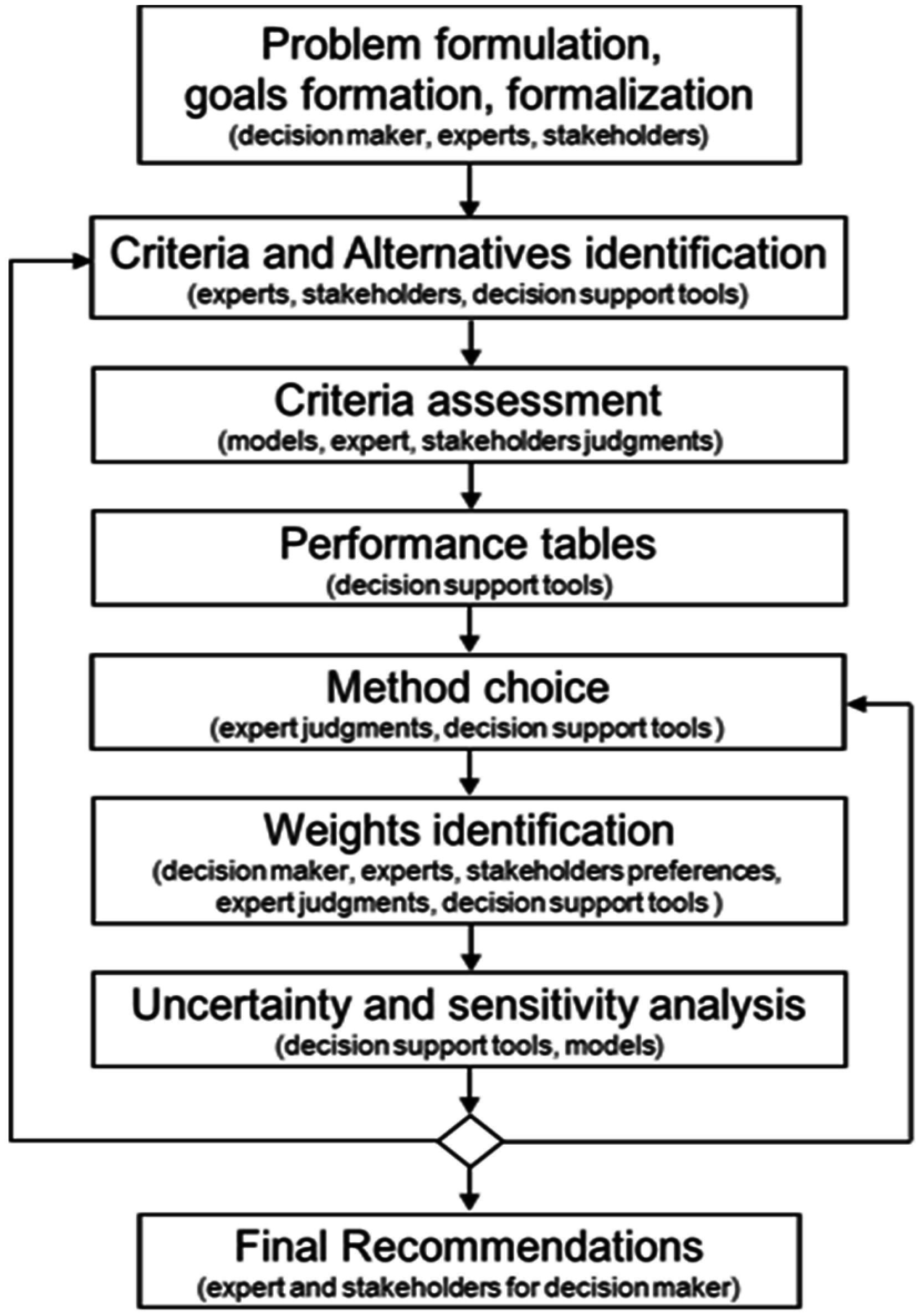
3.1.2. The Main MCDA Steps
3.2. Review of Relevant MCDA Methods
3.2.1. The Most Commonly Used MCDA Methods
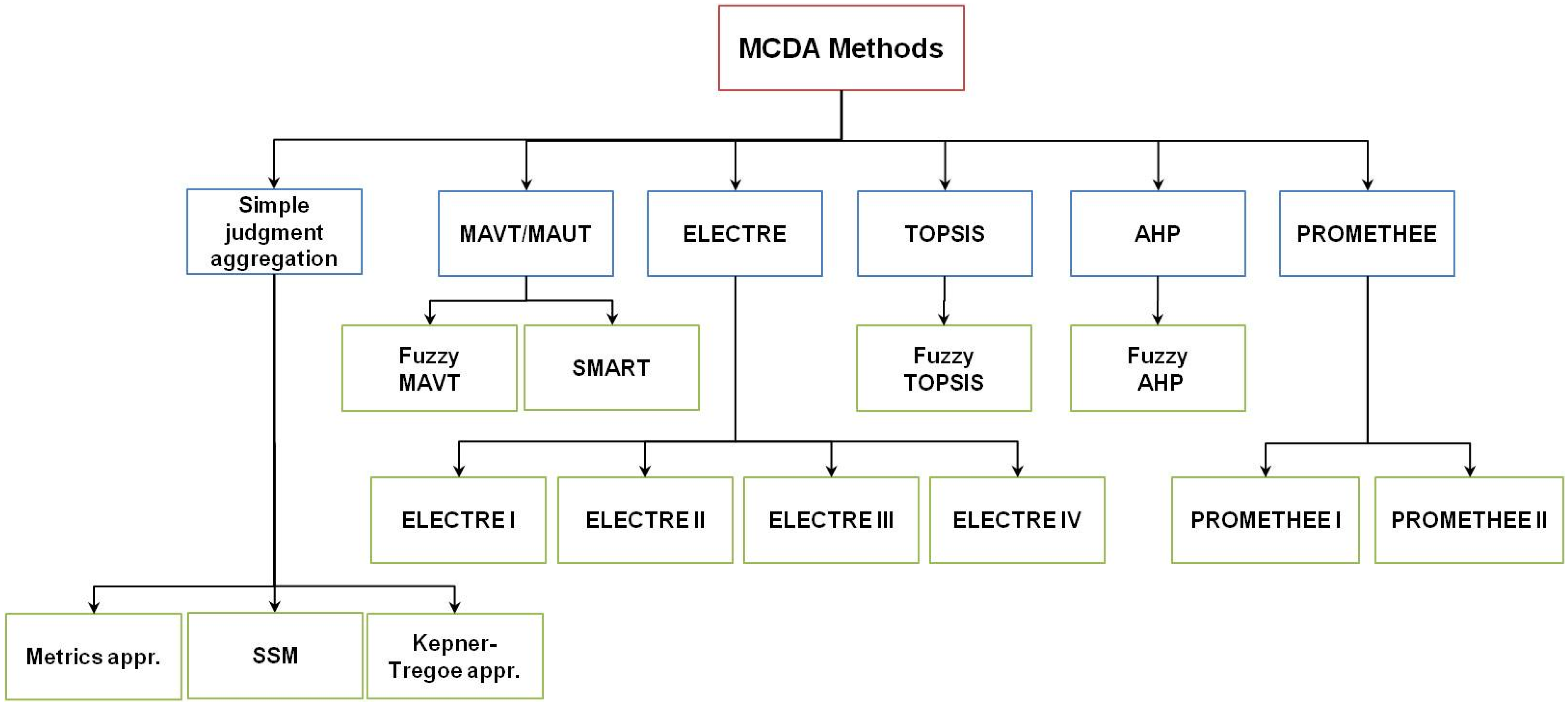
3.2.2. The Features of the MCDA Methods
3.3. Illustrations of Judgments Aggregations for the NESs and NFCs Comparative Assessments
- ▪
- Identification of optimal or more preferable parameters of reactor technologies comprising a related NFC and NES (type, technical and structural characteristics, etc.) Which are promising taking into account preferences of different decision-makers;
- ▪
- Identification of costs, risks and benefits as well as the corresponding trade-off rates associated with the deployment of certain reactor technologies, related NFC and NES from the system viewpoint;
- ▪
- Identification of cost-effective risk mitigation measures for reducing risks associated with the deployment of certain reactor technologies, related NFC and NES (technological innovations, diversification, etc.);
- ▪
- Decisions about R&D resource allocation problem supported by an identification of a limited set of reactor technologies worth R&D budgets alignment to provide sustainable NES deployment.
3.3.1. Aggregated Indicator (Metrics)
3.3.2. Multi-Attribute Value/Utility Theory
| Measures | j | Attributes | Weights |
|---|---|---|---|
| Attractiveness | 1 | Attractiveness level under the US DOE classification (from IB to IVE) | 0.10 |
| 2 | Plutonium heat release (W/kg) | 0.05 | |
| 3 | Fraction of even plutonium isotopes | 0.06 | |
| Concentration | 4 | Concentration (SQ/MT) | 0.10 |
| Handling of material | 5 | Dose rate (rem/h at a distance of 1 м) | 0.08 |
| 6 | Size/weight | 0.06 | |
| Type of accounting and control system | 7 | Measurement frequency | 0.09 |
| 8 | Measurement accuracy (SQ/year) | 0.10 | |
| 9 | Purity of material | 0.03 | |
| 10 | Share of process operations using accounting systems | 0.05 | |
| Accessibility | 11 | Probability of unidentified movements | 0.07 |
| 12 | Physical barriers | 0.10 | |
| 13 | Inventory (SQ) | 0.05 | |
| 14 | Type of fuel charge | 0.06 |
3.3.3. Analytic Hierarchy Process
| Plutonium type | Plutonium in a Reactor | Plutonium in SNF | Separated Plutonium | Plutonium at a Reprocessing Facility | Weight |
|---|---|---|---|---|---|
| Plutonium in a reactor | 1/1 | 1/4 | 1/8 | 1/6 | 0.05 |
| Plutonium in irradiated nuclear fuel | 1/1 | 4/8 | 4/6 | 0.10 | |
| Separated plutonium | 1/1 | 8/6 | 0.55 | ||
| Plutonium at a reprocessing facility | 1/1 | 0.30 |
4. Lesson Learned and Promising Directions of the Future Studies
4.1. New Projects and Endeavors
4.1.1. Strategies for Sustainable Energy Development
4.1.2. Supporting Studies on the Ethics of Nuclear Technology
4.1.3. The IAEA/INPRO KIND Project
- ▪
- Develop a limited number of KIs for the status, prospects, benefits and risks associated with innovative technologies and NESs on their basis;
- ▪
- Adapt advanced methods of expert judgment aggregation within the assessments involving also quantifiable data, to enable effective comparative evaluation of the innovative NESs based on the defined set of KIs;
- ▪
- Using the developed KIs and the adapted methods of expert judgment aggregation, perform case studies on assessment of selected innovative nuclear technologies (NESs on their basis);
- ▪
- Apply the adapted methods of expert judgment aggregation and uncertainty analysis to comparative evaluation of the transition scenarios to future sustainable NESs based on a set of KIs developed in the GAINS project.
4.2. Advanced Methods and Tools
4.2.1. Multi-Objective Decision Making
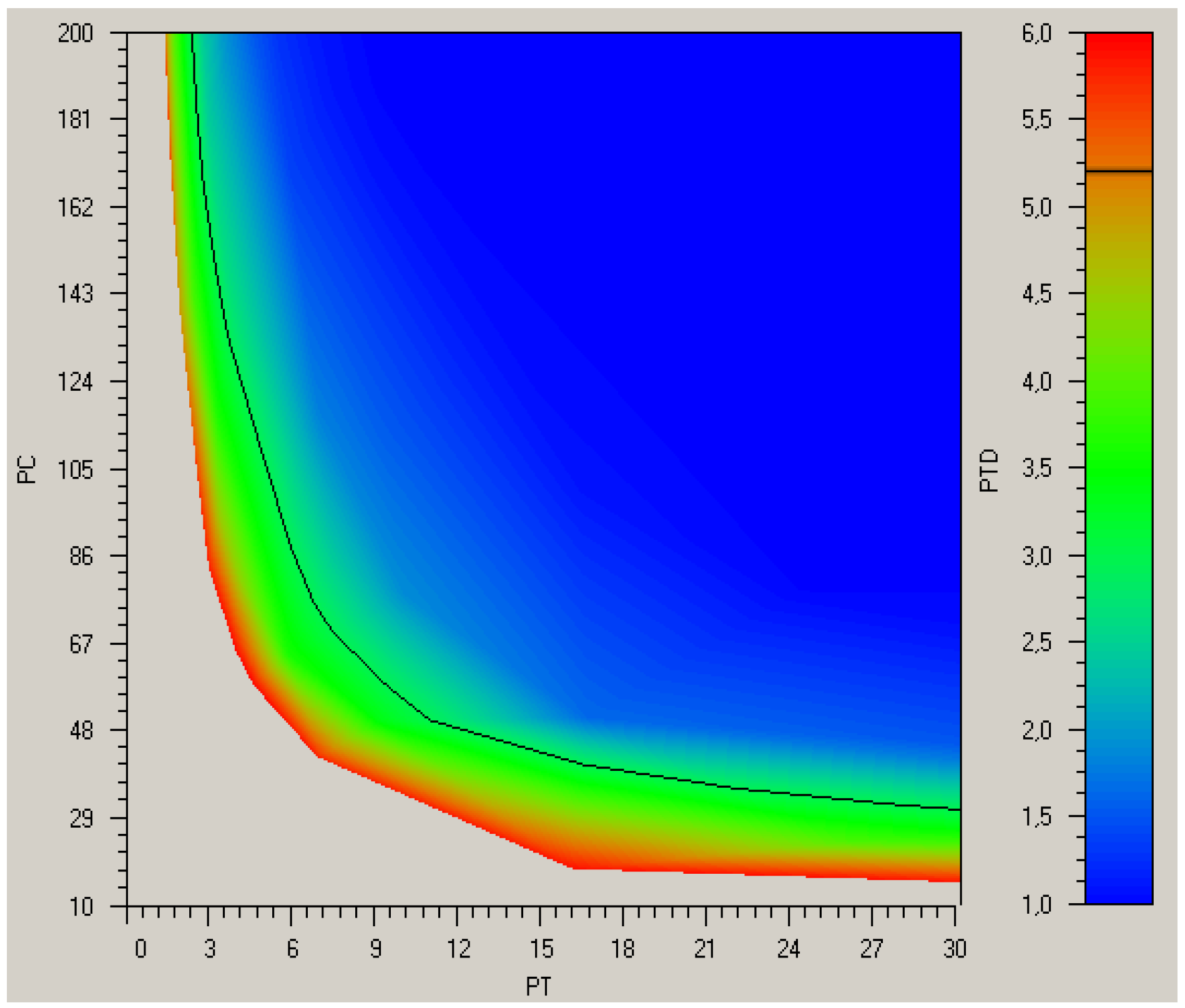
4.2.2. Uncertainty Treatment
4.3. Discussion
4.3.1. General Comments
4.3.2. Recommendations on the MCDM Application
5. Conclusions
Acknowledgments
Author Contributions
Abbreviations
| AHP | Analytic Hierarchy Process |
| ADS | Accelerator Driven System |
| BP | Basic Principle |
| CR | Criteria |
| DOE | Department of Energy |
| ELECTRE | Elimination Et Choix Traduisant la Realite |
| EP | Evaluation Parameter |
| EG | Evaluation Group |
| GAINS | Global Architecture of Innovative Nuclear Energy Systems Based on Thermal and Fast Reactors Including a Closed Fuel Cycle |
| GIF-IV | Generation IV International Forum |
| HLW | High Level Waste |
| IAEA | International Atomic Energy Agency |
| INPRO | International Project on Innovative Nuclear Reactors and Fuel Cycles |
| KI | Key Indicator |
| KIND | Key Indicators for Innovative Nuclear Energy Systems |
| LWR | Light Water Reactor |
| MAVT | Multi-Attribute Value Theory |
| MAUT | Multi-Attribute Utility Theory |
| MCDA | Multi-Criteria Decision Analysis |
| MCDM | Multiple Criteria Decision Making |
| MIT | Massachusetts Institute of Technology |
| MODM | Multi-Objective Decision Making |
| NEA | Nuclear Energy Agency |
| NES | Nuclear Energy System |
| NESA | Nuclear Energy System Assessment |
| NFC | Nuclear Fuel Cycle |
| PROMETHEE | Preference Ranking Organization METHod for Enrichment Evaluations |
| P&T | Partitioning & Transmutation |
| R&D | Research and Development |
| RTA | Reactor Technology Assessment |
| SNF | Spent Nuclear Fuel |
| SSM | Simple Scoring Model |
| TOPSIS | Technique for Order Preference by Similarity to the Ideal Solution |
| TRU | Transuranic Actinides |
| UR | User Requirement |
Conflicts of Interest
References
- International Atomic Energy Agency (IAEA). Nuclear Energy Basic Principles; IAEA Nuclear Energy Series No. NE-BP. IAEA: Vienna, Austria, 2008. Available online: http://www-pub.iaea.org/MTCD/publications/PDF/Pub1374_web.pdf (accessed on 30 March 2015).
- International Atomic Energy Agency (IAEA). International Project on Innovative Nuclear Reactors and Fuel Cycles (INPRO). Available online: http://www.iaea.org/INPRO (accessed on 30 March 2015).
- International Atomic Energy Agency (IAEA). Guidance for the Application of an Assessment Methodology for Innovative Nuclear Energy Systems; Volume 1 of the Final Report of Phase 1 of the International Project on Innovative Nuclear Reactors and Fuel Cycles (INPRO), IAEA-TECDOC-1575. Vienna, Austria, 2007. Available online: http://www-pub.iaea.org/MTCD/publications/PDF/TE_1575_web.pdf (accessed on 30 March 2015).
- International Atomic Energy Agency (IAEA). Framework for Assessing Dynamic Nuclear Energy Systems for Sustainability, Final Report of the INPRO Collaborative Project on Global Architectures of Innovative Nuclear Energy Systems with Thermal and Fast Reactors and a Closed Nuclear Fuel Cycle. IAEA Nuclear Energy Series NP-T-1.14. 2013. Available online: http://www-pub.iaea.org/books/IAEABooks/8873/Framework-for-Assessing-Dynamic-Nuclear-Energy-Systems-for-Sustainability-Final-Report-of-the-INPRO-Collaborative-Project-GAINS (accessed on 30 March 2015).
- International Atomic Energy Agency (IAEA). Nuclear Reactor Technology Assessment for Near Term Deployment; IAEA Nuclear Energy Series NP-T-1.10; IAEA: Vienna, Austria, 2013. Available online: http://www-pub.iaea.org/MTCD/Publications/PDF/Pub1597_web.pdf (accessed on 30 March 2015).
- National Environment Agency (NEA). Trends in the Nuclear Fuel Cycle: Economic, Environmental and Social Aspects; OECD: Paris, France, 2001. Available online: https://www.oecd-nea.org/nea-news/2001/trends19-2.pdf (accessed on 30 March 2015).
- National Environment Agency (NEA). Advanced Nuclear Fuel Cycles and Radioactive Waste Management; OECD: Paris, France, 2006. [Google Scholar]
- National Environment Agency (NEA). Transition towards a Sustainable Nuclear Fuel Cycle; OECD: Paris, France, 2013; No. 7133. [Google Scholar]
- National Environment Agency (NEA). Nuclear Fuel Cycle Synergies and Regional Scenarios for Europe; OECD: Paris, France, 2009; No. 6857. [Google Scholar]
- National Environment Agency (NEA). Potential Benefits and Impacts of Advanced Nuclear Fuel Cycles with Actinide Partitioning and Transmutation; OECD: Paris, France, 2011. [Google Scholar]
- National Environment Agency (NEA). Generation IV Cost Estimating Guidelines Revision 4; GIF EMWG, OECD: Paris, France, 2007. Available online: https://www.gen-4.org/gif/upload/docs/application/pdf/2013–09/emwg_guidelines.pdf (accessed on 30 March 2015).
- Bari, R.A.; Whitlock, J.J.; Therios, I.; Peterson, P.F. Proliferation Resistance and Physical Protection Working Group: Methodology and Applications; OECD NEA: Paris, France, 2013; No. 7141. [Google Scholar]
- Massachusetts Institute of Technology (MIT). The Future of Nuclear Power, an Interdisciplinary MIT Study. 2003. Available online: http://web.mit.edu/nuclearpower/pdf/nuclearpower-full.pdf (accessed on 30 March 2015).
- Massachusetts Institute of Technology (MIT). Update of the MIT 2003 Future of Nuclear Power Study. Available online: http://web.mit.edu/nuclearpower/pdf/nuclearpower-update2009.pdf (accessed on 30 March 2015).
- An Interdisciplinary MIT study. The Future of the Nuclear Fuel Cycle. Available online: https://mitei.mit.edu/system/files/The_Nuclear_Fuel_Cycle-all.pdf (accessed on 30 March 2015).
- Wigeland, R.; Taiwo, T.; Ludewig, H.; Halsey, W.; Gehin, J.; Buelt, J.; Stockinger, S.; Kenni, K.; Todosow, M.; Jubin, R.; et al. Nuclear Fuel Cycle Evaluation and Screening. Final Report “Fuel Cycle Research & Development”, October, 2014, Department of Energy (DOE), FCRD-FCO-2014-000106. Available online: https://inlportal.inl.gov/portal/server.pt/community/nuclear_science_and_technology/337/fuel_cycle_evaluation_and_screening_overview/11124 (accessed on 30 March 2015).
- Keeney, R.; Nair, K. Evaluating Potential Nuclear Power Plant Sites in the Pacific Northwest Using Decision Analysis; International Institute for Applied System Analysis: Laxenburg, Austria, 1976; p. 46. [Google Scholar]
- The Nirex Case study. Generic Repository Studies. 1988–1990. Available online: http://www.davidsmythe.org/nuclear/nirex%202005%20review%20of%201987-91_site_selection.pdf (accessed on 30 March 2015).
- Dyer, J.; Butler, J.; Edmunds, T.; Jia, J. A Multivariate Utility Analysis of the Alternatives for the Disposition of Surplus Weapons-grade plutonium. Oper. Res. 1998, 46, 749–762. [Google Scholar] [CrossRef]
- Hämäläinen, R.P.; Lindstedt, M.R.K.; Sinkko, K. Multi-Attribute Risk Analysis in Nuclear Emergency Management. Risk Anal. 2000, 20, 455–467. [Google Scholar] [CrossRef] [PubMed]
- Butler, J.; Chebeskov, A.; Dyer, J.; Edmunds, T.; Jia, J.; Oussanov, V. The United States and Russia evaluate plutonium disposition options with multi-attribute utility theory. Interfaces 2005, 35, 88–101. [Google Scholar] [CrossRef]
- Charlton, W.S.; LeBouf, R.F.; Gariazzo, C.; Ford, D.G.; Beard, C.; Landsberger, S.; Whitaker, M. Proliferation resistance assessment methodology for nuclear fuel cycles. Nuclear Technol. 2007, 157, 143–156. [Google Scholar]
- Kim, S.K.; Park, H.S.; Lee, K.W.; Jung, C.H. MAUT Approach for selecting a proper decommissioning scenario. In Proceedings of the Waste Management Symposium 2007 Conference, Tucson, AZ, USA, 25 February–1 March 2007.
- PSI/NEEDS project. 2009. Available online: http://www.needs-project.org/ (accessed on 30 March 2015).
- Figueira, J.; Salvatore, G.; Matthias, E. Multiple Criteria Decision Analysis: State of the Art Surveys; Springer Science and Business Media, Inc.: Boston, MA, USA, 2005. [Google Scholar]
- Belton, V.; Stewart, T. Multiple Criteria Decision Analysis: An Integrated Approach; Kluwer Academic Publishers: Dordrecht, The Netherlands, 2002. [Google Scholar]
- Keeney, R.; Raiffa, H. Decision with Multiple Objectives; J. Wiley & Sons: New York, NY, USA, 1976. [Google Scholar]
- Von Winterfeldt, D.; Edwards, W. Decision Analysis and Behavioral Research; University Press: Cambridge, UK, 1986. [Google Scholar]
- Hwang, C.-L.; Yoon, K. Multiple Attribute Decision Making: Methods and Applications; Verlag. Springer: Berlin, Germany, 1981. [Google Scholar]
- Brans, J.; Vincke, P. A Preference Ranking Organization Method: The PROMETHEE Method for Multiple Criteria Decision-making. Manag. Sci. 1985, 31, 647–656. [Google Scholar] [CrossRef]
- Saaty, T. The Analytic Hierarchy Process; McGraw-Hill: New York, NY, USA, 1980. [Google Scholar]
- Bathke, C.G.; Ebbinghaus, B.B.; Sleaford, B.W.; Wallace, R.K.; Collins, B.A.; Hase, K.R.; Jarvinen, G.D.; Bradley, K.S.; Ireland, J.R.; Johnson, M.W.; et al. The attractiveness of materials in advanced nuclear fuel cycles for various proliferation and theft scenarios. In Proceedings of the Global 2009, Paris, France, 6–11 September 2009. Paper No. 9544.
- Saito, M. Development of methodology for plutonium categorization. React. Phys. 2008, 98, 669. [Google Scholar]
- Krakowski, R.A.; Bathke, C.G. Reduction of worldwide plutonium inventories using conventional reactors and advance fuels: A systems study. LA-UR-97-2809. Available online: http://fas.org/sgp/othergov/doe/lanl/lib-www/la-pubs/00412580.pdf (accessed on 30 March 2015).
- Kowalski, K.; Stagl, S.; Madlener, R.; Omann, I. Sustainable energy futures: Methodological challenges in combining scenarios and participatory multi-criteria analysis. Eur. J. Oper. Res. 2009, 197, 1063–1074. [Google Scholar] [CrossRef]
- EUROPEAN COMMISSION. Key Performance Indicators for the European Sustainable Nuclear Industrial Initiative. 2012. Available online: https://setis.ec.europa.eu/system/files/Key_Performance_Indicators_Nuclear.pdf (accessed on 30 March 2015).
- Ashley, S.F.; Fenner, R.A.; Nuttall, W.J.; Parks, G.T. Sustainability Indicators for Open-Cycle. Thorium-Fuelled Nuclear Energy. EPRG Working Paper 1217; Cambridge Working Paper in Economics 1233. Available online: http://www.econ.cam.ac.uk/dae/repec/cam/pdf/cwpe1233.pdf (accessed on 30 March 2015).
- Andrianov, A.A.; Kanke, V.A.; Kuptsov, I.S.; Murogov, V.M. Reexamining the ethics of nuclear technology. Sci. Eng. Ethics 2014, 1–20. [Google Scholar] [CrossRef]
- Kuznetsov, V.; Fesenko, G.; Andrianov, A.; Kuptsov, I. INPRO activities on development of advanced tools to support judgment aggregation for comparative evaluation of nuclear energy systems. Sci. Technol. Nuclear Install. 2015, 2015. [Google Scholar] [CrossRef]
- Andrianov, A. Approaches and software for multi-objective optimization of nuclear power structures. Sustainability 2012, 4, 721–739. [Google Scholar] [CrossRef]
- Andrianov, A.; Kuptsov, I.; Murogov, V. Towards sustainable nuclear power development. Int. J. Nuclear Power 2014, 59, 287–293. [Google Scholar]
- Lotov, A.; Bushenkov, V.; Kamenev, G. Interactive Decision Maps: Approximation and Visualization of the Pareto Frontier; Kluwer Academic Publishers: Dordrecht, The Netherlands, 2004. [Google Scholar]
- Andrianov, A.; Ponomarev-Stepnoy, N.; Rumyantsev, A. Approaches to and Methods for Quantitative Assessment of Nuclear Proliferation Risk; INPE NRNU MEPhI: Obninsk, Russia, 2011; pp. 1–132. [Google Scholar]
- Andrianov, A.; Kuptsov, I. Approach to proliferation risk assessment based on multiple objective analysis framework. In Proceedings of the International Nuclear Fuel Cycle Conference, GLOBAL 2013: Nuclear Energy at a Crossroads, Salt Lake City, USA, September–3 October 2013; Volume 1, pp. 587–593.
- e-Learning educational module ‘Requirements and criteria for nuclear technologies’. Available online: http://lannp.iate.obninsk.ru/course5 (accessed on 30 March 2015).
- Kahraman, C. (Ed.) Fuzzy multi-criteria decision making. Theory and applications with recent developments. In Optimization and Its Applications; Springer: Istanbul, Turkey, 2008; Volume 16.
- Ben-Tal, A.; El Ghaoui, L.; Nemirovski, A. Robust Optimization; Princeton University Press: Princeton, NJ, USA, 2009. [Google Scholar]
© 2015 by the authors; licensee MDPI, Basel, Switzerland. This article is an open access article distributed under the terms and conditions of the Creative Commons Attribution license (http://creativecommons.org/licenses/by/4.0/).
Share and Cite
Kuznetsov, V.; Fesenko, G.; Schwenk-Ferrero, A.; Andrianov, A.; Kuptsov, I. Innovative Nuclear Energy Systems: State-of-the Art Survey on Evaluation and Aggregation Judgment Measures Applied to Performance Comparison. Energies 2015, 8, 3679-3719. https://doi.org/10.3390/en8053679
Kuznetsov V, Fesenko G, Schwenk-Ferrero A, Andrianov A, Kuptsov I. Innovative Nuclear Energy Systems: State-of-the Art Survey on Evaluation and Aggregation Judgment Measures Applied to Performance Comparison. Energies. 2015; 8(5):3679-3719. https://doi.org/10.3390/en8053679
Chicago/Turabian StyleKuznetsov, Vladimir, Galina Fesenko, Aleksandra Schwenk-Ferrero, Andrei Andrianov, and Ilya Kuptsov. 2015. "Innovative Nuclear Energy Systems: State-of-the Art Survey on Evaluation and Aggregation Judgment Measures Applied to Performance Comparison" Energies 8, no. 5: 3679-3719. https://doi.org/10.3390/en8053679
APA StyleKuznetsov, V., Fesenko, G., Schwenk-Ferrero, A., Andrianov, A., & Kuptsov, I. (2015). Innovative Nuclear Energy Systems: State-of-the Art Survey on Evaluation and Aggregation Judgment Measures Applied to Performance Comparison. Energies, 8(5), 3679-3719. https://doi.org/10.3390/en8053679





